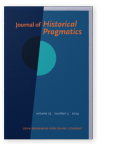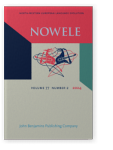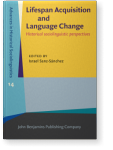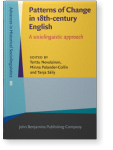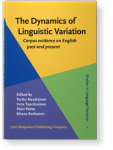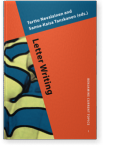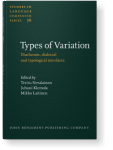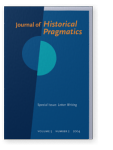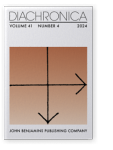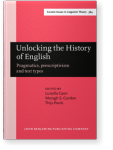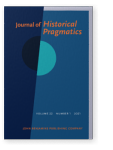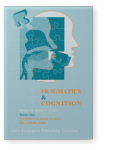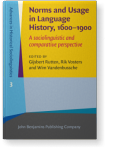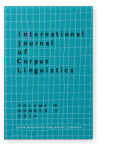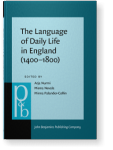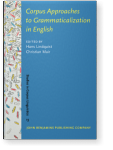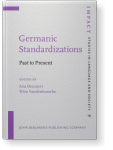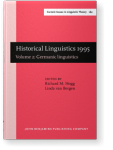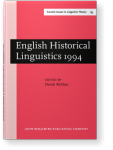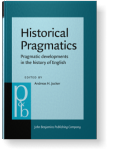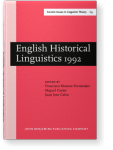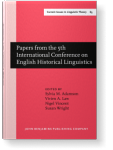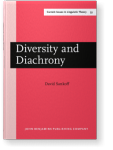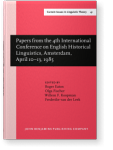Terttu Nevalainen
List of John Benjamins publications for which Terttu Nevalainen plays a role.
Journals
Book series
Patterns of Change in 18th-century English: A sociolinguistic approach
Edited by Terttu Nevalainen, Minna Palander-Collin and Tanja Säily
[Advances in Historical Sociolinguistics, 8] 2018. xi, 311 pp.
Subjects English linguistics | Germanic linguistics | Historical linguistics | Sociolinguistics and Dialectology
The Dynamics of Linguistic Variation: Corpus evidence on English past and present
Edited by Terttu Nevalainen, Irma Taavitsainen, Päivi Pahta and Minna Korhonen
[Studies in Language Variation, 2] 2008. viii, 339 pp.
Subjects Corpus linguistics | English linguistics | Germanic linguistics | Historical linguistics | Sociolinguistics and Dialectology | Theoretical linguistics
Letter Writing
Edited by Terttu Nevalainen and Sanna-Kaisa Tanskanen
[Benjamins Current Topics, 1] 2007. viii, 160 pp.
Subjects Discourse studies | Historical linguistics | Pragmatics
Types of Variation: Diachronic, dialectal and typological interfaces
Edited by Terttu Nevalainen, Juhani Klemola and Mikko Laitinen
[Studies in Language Companion Series, 76] 2006. viii, 378 pp.
Subjects Historical linguistics | Theoretical linguistics | Typology
Letter Writing
Edited by Terttu Nevalainen and Sanna-Kaisa Tanskanen
Special issue of Journal of Historical Pragmatics 5:2 (2004) iv, 181 pp.
Subjects Discourse studies | Historical linguistics | Pragmatics
2024 Diachrony and Diachronica: 40@40 Diachronica 41:4, pp. 556–574 | Editorial
2024 Changing styles of letter-writing? Evidence from 400 years of early English letters in a POS-tagged corpus Unlocking the History of English: Pragmatics, prescriptivism and text types, Caon, Luisella, Moragh S. Gordon and Thijs Porck (eds.), pp. 154–179 | Chapter
We analyse the social embedding of stylistic change in the frequencies of nouns, lexical verbs and personal pronouns in the Corpora of Early English Correspondence from the fifteenth to the eighteenth century. Our visualization methods show that the frequency of nouns exhibits a consistent… read more
2018 Chapter 2. Society and culture in the long 18th century Patterns of Change in 18th-century English: A sociolinguistic approach, Nevalainen, Terttu, Minna Palander-Collin and Tanja Säily (eds.), pp. 13–26 | Chapter
2018 Chapter 1. Approaching change in 18th-century English Patterns of Change in 18th-century English: A sociolinguistic approach, Nevalainen, Terttu, Minna Palander-Collin and Tanja Säily (eds.), pp. 3–12 | Chapter
2018 From speaker innovation to lexical change: A sociohistorical approach to neologisms The Dynamics of Lexical Innovation: Data, methods, models, Kerremans, Daphné, Jelena Prokić, Quirin Würschinger and Hans-Jörg Schmid (eds.), pp. 8–29 | Article
Applying a sociolinguistic approach to the study of neologisms, this paper discusses the actuation and diffusion of new words in Early Modern English (EModE; 1500–1700) and draws some parallels with word coining in the comparable but more recent period of Early Modern Finnish (EModF; 1810–1880).… read more
2018 Chapter 7. Going to completion: The diffusion of verbal ‑s Patterns of Change in 18th-century English: A sociolinguistic approach, Nevalainen, Terttu, Minna Palander-Collin and Tanja Säily (eds.), pp. 97–116 | Chapter
2018 Chapter 16. A wider sociolinguistic perspective Patterns of Change in 18th-century English: A sociolinguistic approach, Nevalainen, Terttu, Minna Palander-Collin and Tanja Säily (eds.), pp. 255–270 | Chapter
2015 Age-related variation and language change in Early Modern English Language Development: The lifespan perspective, Gerstenberg, Annette and Anja Voeste (eds.), pp. 129–146 | Article
Focusing on the age variable in real-time language change, my paper traces age-related variation among people taking part in several ongoing changes. More specifically, I examine the age-related patterns characteristic of linguistically progressive and conservative individuals in the English… read more
2014 Norms and usage in seventeenth-century English Norms and Usage in Language History, 1600–1900: A sociolinguistic and comparative perspective, Rutten, Gijsbert, Rik Vosters and Wim Vandenbussche (eds.), pp. 103–128 | Article
In the course of the seventeenth century English spelling became largely fixed in print, and technical and borrowed lexis continued to be codified in dictionaries. Although proposals for ‘improving’ the English language appeared towards the end of the century, contemporary grammar books did not… read more
2014 Text Variation Explorer: Towards interactive visualization tools for corpus linguistics International Journal of Corpus Linguistics 19:3, pp. 417–429 | Article
This paper reviews the gap between current methods of text visualization and the needs of corpus-linguistic research, and introduces a tool that takes a step towards bridging that gap. Current text visualization methods tend to treat the problem as a data-encoding issue only, and do not strive for… read more
2009 Grasshoppers and blind beetles: Caregiver language in Early Modern English correspondence The Language of Daily Life in England (1400–1800), Nurmi, Arja, Minna Nevala and Minna Palander-Collin (eds.), pp. 137–164 | Article
This case study examines caregiver language in sixteenth- and seventeenth-century letters. It addresses the general issue of how parents and other caregivers talked about and communicated with children and adolescents in their personal correspondence, and, more specifically, to what extent it is… read more
2008 Exploring the dynamics of linguistic variation through public and private corpora The Dynamics of Linguistic Variation: Corpus evidence on English past and present, Nevalainen, Terttu, Irma Taavitsainen, Päivi Pahta and Minna Korhonen (eds.), pp. 1–9 | Article
2007 Introduction Letter Writing, Nevalainen, Terttu and Sanna-Kaisa Tanskanen (eds.), pp. 1–11 | Article
2006 Vernacular universals? The case of plural was in Early Modern English Types of Variation: Diachronic, dialectal and typological interfaces, Nevalainen, Terttu, Juhani Klemola and Mikko Laitinen (eds.), pp. 351–369 | Article
2006 ‘Triangulation’ of diachrony, dialectology and typology: An overview Types of Variation: Diachronic, dialectal and typological interfaces, Nevalainen, Terttu, Juhani Klemola and Mikko Laitinen (eds.), pp. 3–19 | Article
2004 Introduction Letter Writing, Nevalainen, Terttu and Sanna-Kaisa Tanskanen (eds.), pp. 181–191 | Article
2004 Three perspectives on grammaticalization: Lexico-grammar, corpora and historical sociolinguistics Corpus Approaches to Grammaticalization in English, Lindquist, Hans and Christian Mair (eds.), pp. 1–31 | Article
The intersection of lexis and grammar normally provides the focus for the study of grammaticalization. This paper discusses how the focus can be widened by corpus linguistic and sociolinguistic approaches, but is also illustrates the challenges that grammaticalization processes present to… read more
2003 English Germanic Standardizations: Past to Present, Deumert, Ana and Wim Vandenbussche (eds.), pp. 127–156 | Article
1998 Reconstructing the social dimension of diachronic language change Historical Linguistics 1995: Volume 2: Germanic linguistics, Hogg, Richard M. and Linda van Bergen (eds.), pp. 189–210 | Article
1996 Social stratification in Tudor English? English Historical Linguistics 1994: Papers from the 8th International Conference on English Historical Linguistics (8 ICEHL, Edinburgh, 19–23 September 1994), Britton, Derek (ed.), pp. 303–326 | Article
1995 Constraints on Politeness: The Pragmatics of Address Formulae in Early English Correspondance Historical Pragmatics: Pragmatic developments in the history of English, Jucker, Andreas H. (ed.), pp. 541–602 | Article
1994 Ladies and gentlemen: the generalization of titles in early modern English English Historical Linguistics 1992: Papers from the 7th International Conference on English Historical Linguistics, Valencia, 22–26 September 1992, Fernández, Francisco, Miguel Fuster Márquez and Juan Jose Calvo (eds.), pp. 317–328 | Article
1990 Modelling functional differentiation and function loss: the case of but Papers from the 5th International Conference on English Historical Linguistics, Adamson, Sylvia M., Vivien A. Law, Nigel Vincent and Susan Wright (eds.), pp. 337–356 | Article
1986 The development of preverbal only in early modern English Diversity and Diachrony, Sankoff, David, pp. 111–121 | Article
1985 Lexical variation of early modern English exclusive adverbs: Style switching or a change in progress? Papers from the 4th International Conference on English Historical Linguistics, Amsterdam, April 10–13, 1985, Eaton, Roger, Olga Fischer, Willem F. Koopman and Frederike van der Leek (eds.), pp. 179–194 | Article
